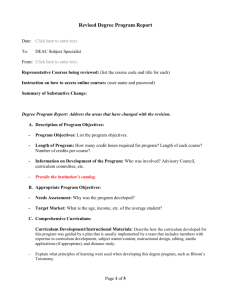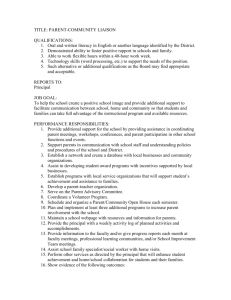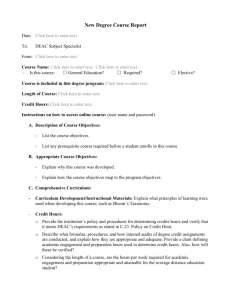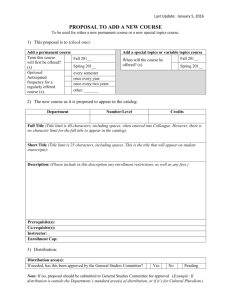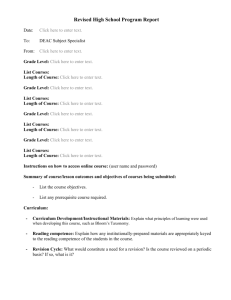Change in Method of Delivery Report
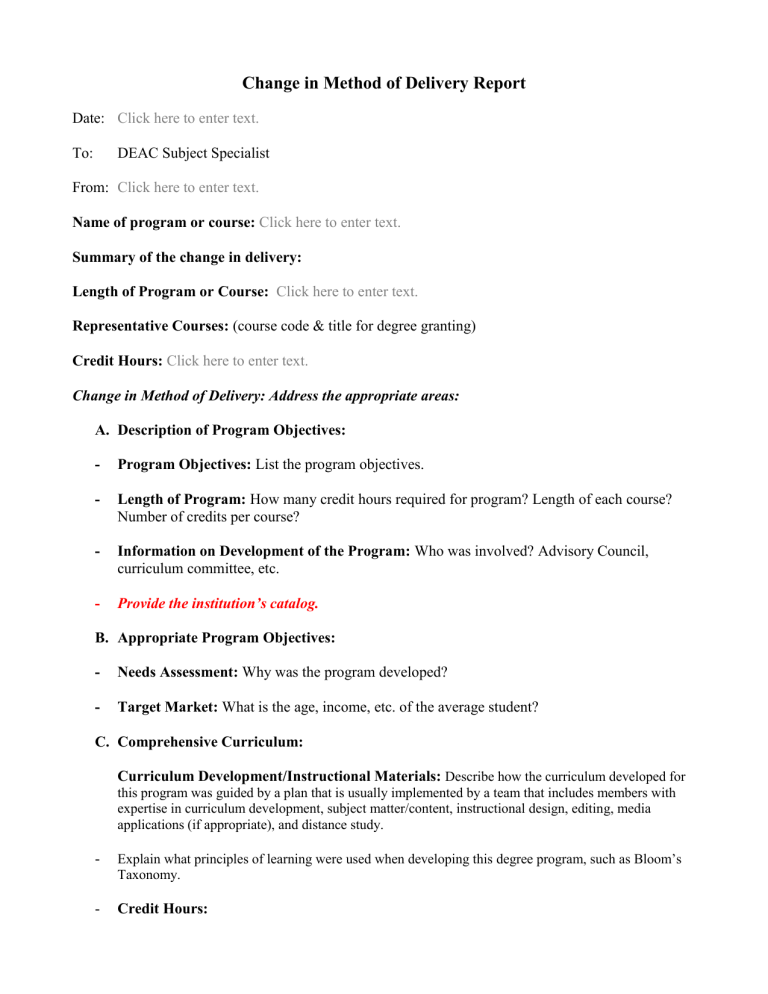
Change in Method of Delivery Report
Date: Click here to enter text.
To: DEAC Subject Specialist
From: Click here to enter text.
Name of program or course: Click here to enter text.
Summary of the change in delivery:
Length of Program or Course: Click here to enter text.
Representative Courses: (course code & title for degree granting)
Credit Hours: Click here to enter text.
Change in Method of Delivery: Address the appropriate areas:
A.
Description of Program Objectives:
Program Objectives: List the program objectives.
Length of Program: How many credit hours required for program? Length of each course?
Number of credits per course?
Information on Development of the Program: Who was involved? Advisory Council, curriculum committee, etc.
-
Provide the institution’s catalog.
B.
Appropriate Program Objectives:
Needs Assessment: Why was the program developed?
Target Market: What is the age, income, etc. of the average student?
C.
Comprehensive Curriculum:
Curriculum Development/Instructional Materials: Describe how the curriculum developed for this program was guided by a plan that is usually implemented by a team that includes members with expertise in curriculum development, subject matter/content, instructional design, editing, media applications (if appropriate), and distance study.
Explain what principles of learning were used when developing this degree program, such as Bloom’s
Taxonomy.
Credit Hours:
o Verify that the degree awarded consist of the minimum semester hours or quarter hours required. Associate Degree (60 semester hours or 90 quarter hours); Baccalaureate Degree (120 semester hours or 180 quarter hours); Master’s Degree (36 semester hours or 54 quarter hours);
First Professional Degree (50 semester hours or 75 quarter hours); Professional Doctorate
Degree (60 graduate level semester hours or 90 graduate hours after the baccalaureate degree). o Verify that the degree awarded consist of the minimum semester hours or quarter hours in the general education courses as required by DEAC. (Associate Degree [one-fourth of credits required] and Baccalaureate Degree [one-fourth of credits required]).
-
Institution’s Policy on Determining Credit Hours: o Provide the institution’s policy and procedures for determining credits hours and verify that it meets
DEAC’s requirements as stated in C.23. Policy on Credit Hour. o Describe what formulas, procedures, and how internal audits of degree credit assignments are conducted, and explain how they are appropriate and adequate. Provide a chart defining academic engagement and preparation hours used to determine credit hours. Also, explain how these will be verified, (i.e., surveying students). o Considering the length of a course, explain how the hours per week required for academic engagement and preparation appropriate are attainable for the average distance education student.
List each course: (include course code and title)
General Education:
Required:
Electives:
Prerequisites: (list any requirements for prerequisites)
Professional Doctoral Degree: Provide a copy of the Doctoral Program handbook.
D.
Up-To-Date Curriculum:
Revision Cycle: Explain what would constitute a need for a revision of the curriculum. Explain how the curriculum is reviewed on a periodic basis and provide the revision schedule.
E.
Comprehensive and Up-to-Date Instructional Materials:
Comprehensive: Explain how the institution assures that the instructional materials are sufficiently comprehensive and that they have depth and breadth to adequately meet the program objectives.
Up-to-Date : Explain how the institution assures that the instructional materials are accurate and that they reflect current knowledge and practice in the field.
F.
Examinations and Other Assessments:
Exams and assignments: Explain how the institution determines the number and length of exam and/or assignments needed to adequately measure if sufficient student achievement of courses objectives has taken place.
Provide copies of the examinations and other assessments, along with the solutions.
Other Assessments: Explain how the required learning activities adequately measure the student’s ability to master and apply the skills or knowledge that are stated as outcomes.
Outcomes Assessments: Describe any direct and/or indirect measures you are planning to use or have used to measure expected outcomes (see C.14. Policy on Student Achievement and
Satisfaction).
Information on Proctored Examinations: Provide the policies and procedures for proctoring.
Include details on the number of courses proctored.
Grading Criteria: Provide the institution’s academic grading policies, assignment marking system, course extension policy, and information on issuance and completion of grades.
Rubrics : Provide a copy of the any grading rubrics used in the degree program.
Capstone Projects: If this program requires a capstone project, provide details on what is required.
Dissertation or Research Project: If this program requires a dissertation or research project, provide details on what is required.
G.
Authorship:
Textbooks: Explain how the textbooks where selected, how they are appropriate, and how they are suitable for distance study.
Instructional Materials: Explain who wrote any instructional material and how they are qualified in their subject or field.
Table of Subject Matter Experts/Consultants who prepared the materials for the degree program: If the instructional materials were prepared by someone other than the faculty member, please provide the information below: (also provide resumes)
Name Educational
Qualifications
What courses Other Experience Special Training in
DL
(degrees earned)
Provide textbooks for the representative courses you are sending. List name, ISBN #, and corresponding course title.
H.
Organization of Instructional Materials:
Learning and Design Principle:
ADDIE?
Explain what instructional design models were used, such as
I.
Curriculum Delivery:
Technology Requirements: Describe how students are informed of any technology requirements needed to complete the program before they enroll.
Online Platform: Explain what online learning platform is used.
Training and Support: Explain how students and faculty are trained and supported when using any technology.
Reading Competence: Explain how any institutionally-prepared materials are appropriately keyed to the reading competence of the students in the program.
J.
Study Instructions:
How to Study: Explain how students are instructed how to study and to proceed through each course in the degree program.
Proceed through the Program: Explain how students are provided with a degree plan, which shows what courses are completed and/or need to be completed to finish the program.
Online Instructions: Explain how students are instructed on how to access chat rooms, bulletin boards, and other appropriate resources.
K.
Educational Media and Learning Resources:
Educational Media: Explain how educational media is properly integrated with the texts and assignments. Describe how these are supplied to students at the appropriate times.
Learning Resources: Explain how the program designers and/or faculty made effective use of appropriate teaching aids and learning resources. How are the learning resources selected? Who is involved in making the selection? Do the devices/technologies enhance learning interactivity?
Library Learning Resources: Explain how the institution provides access to library media services and publications needed so that students may meet the objectives for the degree program.
Review of Services: Explain how the library services are systematically and regularly evaluated to ensure they are meeting the needs of its users and supporting the programs and objectives of the institution.
Qualified Library Facilitator: Provide the educational qualifications and experience of the library media facilitator.
L.
Student Privacy, Integrity, and Identity:
Policies: Provide the institution’s policies related to student privacy, integrity and academic honesty. Where are these published?
Student Identity:
Explain how the institution verifies a student’s identity.
VI. Qualifications of Faculty: Provide the following for each faculty member who will be teaching in this degree program. Also provide their resumes.
Table of Faculty for the degree program
Faculty Name Educational
Qualifications
Courses he/she will
(degrees earned) Teach in this
Program
Also include the following information:
Weekly hours
Other Experience Special Training in
DL
Document that the faculty meets DEAC’s requirements for qualifications. (See C.9. Policy on
Degree Programs.)
Explain if any exceptions were made for qualifications required by DEAC (C.9.) and documented for professionals whose experiences and reputations qualifies them for appointment as faculty (full-time or adjunct).
First Professional: Document that all teaching faculty and involved practitioners hold the First
Professional or higher degree, in a subject area relevant to the program that is being offered. o Explain how all teaching faculty and involved practitioners have experience in the First
Professional degree program or in graduate-level distance education in a related subject area and in teaching adult students. o Explain how there is a sufficient number of qualified faculty members and practitioners to meet the academic and clinical needs and requirements of the program.
Professional Doctorate Degree: Document that all faculty members instructing doctoral students have a terminal degree in a relevant field of study (either a professional doctorate or a doctor of philosophy). o Verify that the institution has on its full-time staff, prior to enrolling students, a Dean or other academic officer with credentials that are appropriate to the degree(s) being offered.
